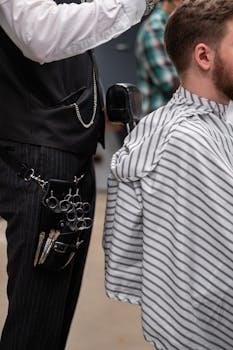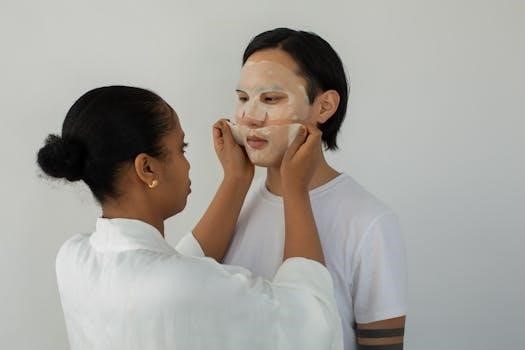Bearded Dragon Care Sheet⁚ A Comprehensive Guide
Considering a bearded dragon? This comprehensive guide offers a wealth of information. From understanding their fascinating behaviors and docile temperament to creating the perfect environment, it will equip you with everything needed to thrive.
Bearded dragons, scientifically known as Pogona vitticeps, are captivating lizards. They are known for their gentle nature and dragon-like appearance. Originating from Australia, they’ve gained immense popularity as pets. Beardies exhibit fascinating behaviors and show a unique ability to adapt to captivity. This makes them ideal pets for both novice reptile enthusiasts and seasoned keepers.
Their name comes from the flap of skin on their chin. They can project their beard and show off dark scales to ward off predators. They also stiffen the spines on the sides of their body for protection.
This comprehensive care guide covers the essential aspects. It includes habitat setup, proper diet, and health maintenance. By understanding their needs, you can ensure a long, happy, and healthy life for your bearded dragon. So, let’s delve into the world of bearded dragons and discover how to provide them with the best possible care.

Understanding Bearded Dragon Basics
Before bringing a bearded dragon home, understanding their origins, physical characteristics, and lifespan is crucial. This will allow you to provide optimal care and meet their specific needs effectively.
Origin and Habitat
Bearded dragons (Pogona vitticeps) hail from the arid and semi-arid regions of Australia. Since the 1960s, it has been illegal to export them from Australia. In their native land, they inhabit a diverse range of environments, including deserts, scrublands, savannas, and dry forests, often basking on rocks, asphalt, and farm fences.
These reptiles have adapted to survive in harsh conditions. They are frequently found in the desert areas of Australia in the rocks and sand and have a beautiful tan and brown marbled pattern along their back as well as down their long tails to camouflage in with their surroundings.
Their natural habitat informs their care requirements in captivity. Understanding their origin is essential for replicating their environment.
Physical Characteristics and Size
Bearded dragons are stocky lizards with a distinctive appearance. Adults typically reach 18 to 24 inches in length, from head to tail. They possess a triangular-shaped head, a flattened body, and a long, tapering tail. Small, spiny scales run along their sides and form a “beard” under their chin.
Their coloration is typically tan or brown, often with darker brown markings along their backs. However, selective breeding has produced a variety of color morphs, including red, orange, yellow, white, and even light purple or blue. Hatchlings are much smaller, measuring only four to five inches long.
These physical traits contribute to their unique charm, making them popular reptile pets.
Lifespan and Factors Affecting It
Bearded dragons typically live for 4 to 15 years in captivity, although some individuals have been known to live even longer, reaching over 18 years of age. Several factors can influence their lifespan, with proper care and husbandry being paramount.
Inadequate care, such as improper diet, insufficient lighting, and poor enclosure conditions, can lead to various health problems and significantly shorten their lifespan. Providing a balanced diet, appropriate UVB and basking temperatures, and a clean, spacious enclosure are crucial for ensuring a long and healthy life for your bearded dragon.
Genetics and overall health can also play a role in determining their lifespan.

Essential Care Requirements
Providing optimal care involves understanding their needs. This includes a suitable enclosure, proper lighting and heating. Also, a balanced diet of both insects and plant matter will keep your dragon healthy.
Enclosure Setup⁚ Tank Size and Environment
A proper enclosure is crucial for a bearded dragon’s health and well-being. For adults, aim for a 75-gallon tank or larger. A spacious environment allows for thermoregulation and enrichment. Hatchlings can temporarily reside in 20-gallon tanks. However, they should eventually be upgraded to a larger enclosure as they grow.
Consider a dedicated reptile tank or a glass fish tank with a secure top. Avoid mesh tops, as they can make it difficult to maintain proper temperatures and humidity. The enclosure should mimic their natural desert habitat, with a warm basking spot and a cooler area.
A temperature gradient is essential for thermoregulation. Provide adequate ventilation and ensure the enclosure is cleaned regularly. Select appropriate substrate and decorations to create a stimulating and enriching environment for your bearded dragon.
Lighting and Heating⁚ UVB and Basking Requirements
Proper lighting and heating are paramount for the health of bearded dragons. They need both UVB and basking lights to thrive. UVB light is essential for vitamin D3 synthesis. This in turn facilitates calcium absorption, preventing metabolic bone disease. A UVB tube should span at least half the length of the enclosure.
Replace UVB bulbs every six months, as their output diminishes over time. Basking lamps provide the necessary heat for thermoregulation. Maintain a basking spot temperature of 95-105°F. A temperature gradient should exist within the enclosure, with a cooler side around 75-85°F.
Use a thermometer to monitor temperatures accurately. At night, temperatures can drop to 65-75°F. Avoid using heat rocks, as they can cause burns. Position lights appropriately to prevent direct contact with your bearded dragon. Ensure proper ventilation to prevent overheating.
Diet and Feeding⁚ Insects and Plant Matter
A balanced diet is crucial for a healthy bearded dragon. Their diet should consist of both insects and plant matter. Young bearded dragons need a higher proportion of insects, around 80% insects and 20% plant matter. As they mature, this ratio shifts to approximately 60% plant matter and 40% insects.
Offer a variety of insects such as crickets, dubia roaches, and mealworms. Gut-load insects with nutritious foods before feeding them to your dragon. Provide fresh, dark leafy greens like collard greens, mustard greens, and dandelion greens. You can also offer small amounts of fruits and vegetables such as squash, carrots, and berries.
Avoid feeding them spinach, avocado, and rhubarb, as they can be harmful. Offer food in a shallow dish to prevent substrate ingestion. Adjust the quantity of food based on your dragon’s age, size, and activity level. Always provide fresh water in a shallow dish.

Daily and Weekly Care
Maintaining a consistent routine is essential for your bearded dragon’s well-being. This includes daily feeding, spot cleaning, and weekly baths to ensure optimal health and happiness.
Feeding Schedule and Gut-Loading Insects
Establishing a consistent feeding schedule is crucial for your bearded dragon’s health, especially during its growth stages. Young bearded dragons require more frequent feedings due to their rapid development. Offer insects multiple times a day, gradually decreasing the frequency as they mature into adults.
Gut-loading insects is an essential practice to maximize the nutritional value of their diet. This involves feeding insects a nutritious diet of fresh fruits, vegetables, and commercial gut-loading products for at least 24 hours before offering them to your bearded dragon. This ensures that your pet receives the essential vitamins and minerals they need.
Dusting insects with calcium and vitamin D3 supplements is also recommended, particularly for young dragons. This helps prevent metabolic bone disease, a common ailment in captive reptiles. A varied diet of properly gut-loaded and supplemented insects, along with fresh greens, will contribute to a healthy and thriving bearded dragon. Always research safe food.
Bathing and Hydration
Bathing is an important part of bearded dragon care, contributing to both hydration and hygiene. While they primarily obtain moisture through their food, occasional baths help maintain proper hydration levels. Bathing also aids in shedding and prevents the buildup of dirt and debris on their skin.
Prepare a shallow bath with lukewarm water, ensuring the water level is no higher than their shoulders. Gently place your bearded dragon in the bath, allowing them to soak for 10-15 minutes. Supervise them closely during the bath to prevent drowning. You can gently pour water over their back to encourage drinking and aid in shedding.
Some bearded dragons may drink during their bath, while others may not. Regardless, the warm water helps them absorb moisture through their vent. After the bath, gently pat them dry with a soft towel and return them to their warm enclosure. Regular bathing, typically once a week, promotes healthy skin and proper hydration.
Handling and Socialization
Bearded dragons are generally docile and enjoy interaction with their owners, making handling and socialization crucial aspects of their care. Start by allowing your bearded dragon to acclimate to its new environment for a few days before attempting to handle it.
Approach your bearded dragon slowly and gently, avoiding sudden movements that may startle it. Offer your hand from the side, allowing it to see you clearly. If your bearded dragon appears relaxed, gently scoop it up with both hands, supporting its body and legs.
Keep handling sessions short and positive, gradually increasing the duration as your bearded dragon becomes more comfortable. Avoid squeezing or restraining your bearded dragon, as this can cause stress. Regular handling helps your bearded dragon become accustomed to your presence, reducing the likelihood of defensive behaviors.
Supervise interactions with children closely, teaching them how to handle the bearded dragon gently and respectfully. With patience and consistent interaction, your bearded dragon will become a well-socialized and enjoyable companion.

Health and Well-being
Maintaining optimal health is vital for your bearded dragon’s longevity. Recognizing potential problems, understanding preventive measures, and choosing the right vet are essential for ensuring a happy and healthy life.
Common Health Problems and Prevention
Bearded dragons, while hardy, are prone to specific health issues. Metabolic Bone Disease (MBD), a common ailment, stems from insufficient UVB exposure or calcium deficiency. Prevent MBD by providing adequate UVB lighting and supplementing their diet with calcium. Respiratory infections can occur due to improper temperature or humidity levels; ensure proper enclosure setup. Impaction, caused by ingesting indigestible substrates or large insects, can be avoided by using appropriate substrates like paper towels or tile and feeding appropriately sized prey.
Parasites, both internal and external, are another concern. Regular fecal exams by a veterinarian can detect internal parasites, while proper hygiene and quarantine procedures can prevent external parasites like mites. Mouth rot, an infection of the mouth, is often caused by injury or poor hygiene. Maintain a clean enclosure and address any injuries promptly. By understanding these common health problems and implementing preventive measures, you can help your bearded dragon live a long and healthy life.
Signs of a Healthy Bearded Dragon
A healthy bearded dragon exhibits several key indicators. Its eyes should be bright, clear, and alert, without any discharge or swelling. The skin should be vibrant, with normal coloration for its morph, and free of lesions, shedding issues, or parasites. A healthy beardie will have a good appetite, readily consuming insects and plant matter. Regular, well-formed stools are also a sign of proper digestion and overall health.
Active behavior is another important indicator. A healthy bearded dragon will be alert and responsive, exploring its enclosure and basking under its heat lamp. It should be able to move around easily, without any signs of weakness or difficulty. Furthermore, a healthy respiratory system is vital, with no signs of labored breathing, wheezing, or nasal discharge. By observing these signs, you can ensure your bearded dragon is thriving.
Choosing a Veterinarian
Selecting the right veterinarian is crucial for your bearded dragon’s well-being. Not all vets have experience with reptiles, so it’s essential to find one specializing in exotic animals. Start by asking fellow reptile owners, local herpetological societies, or your breeder for recommendations. Once you have a list, call each vet and inquire about their experience with bearded dragons, their understanding of reptile-specific diseases, and their availability for emergencies.
Consider factors like location, office hours, and fees, but prioritize expertise and a caring attitude. A good reptile vet should be knowledgeable about bearded dragon husbandry, nutrition, and common health problems. They should also be willing to answer your questions and explain treatment options clearly. Before your first visit, gather your bearded dragon’s health history, including its diet, enclosure setup, and any previous medical issues. A proactive approach ensures your beardie receives the best possible care.
